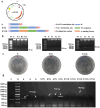Boosting Expression of a Specifically Targeted Antimicrobial Peptide K in Pichia pastoris by Employing a 2A Self-Cleaving Peptide-Based Expression System
- PMID: 39452252
- PMCID: PMC11505851
- DOI: 10.3390/antibiotics13100986
Boosting Expression of a Specifically Targeted Antimicrobial Peptide K in Pichia pastoris by Employing a 2A Self-Cleaving Peptide-Based Expression System
Abstract
Background/Objectives: The current epidemic of drug-resistance bacterial strains is one of the most urgent threats to human health. Antimicrobial peptides (AMPs) are known for their good activity against multidrug resistance bacteria. Specifically targeted AMPs (STAMPs) are a fraction of AMPs that target specific bacteria and maintain the balance of the healthy microbiota of a host. We reported a STAMP Peptide K (former name: peptide 13) for E. coli. The aim of this study was to effectively produce peptide K using methylotrophic yeast Pichia pastoris. Methods: Three inserts (sequence of peptide K (K), two copies of peptide K fused with 2A sequence (KTK), and two copies of peptide K fused with 2A and an extra α mating factor (KTAK)) were designed to investigate the effect of the number of repeats and the trafficking of peptide on the yield. Results: The yield from KTK was the highest-more than two-fold higher compared with K-implying the role of the 2A sequence in heterologous peptide expression apart from the co-translation. Then, the fermentation condition for KTK was optimized. The optimized yield of KTK was 6.67 mg/mL, suggesting the efficiency of the expression system. Selectivity, antibacterial activity, biocompatibility, and the stability of the fermentation product were equivalent to the chemically synthesized peptide. The actional mechanism of the fermentation product included membrane permeabilization and ROS induction. Conclusions: Together, our work provided a new perspective to augment the yield of the antimicrobial peptide in the microbial system, building a technological foundation for their large-scale production and expanding the market application of AMPs.
Keywords: 2A self-cleaving peptide; Pichia pastoris; fermentation condition optimization; selective targeted antimicrobial peptide.
Conflict of interest statement
The authors declare no conflict of interest.
Figures




Similar articles
-
Recombinant production of the antimicrobial peptide NZ17074 in Pichia pastoris using SUMO3 as a fusion partner.Lett Appl Microbiol. 2014 Jul;59(1):71-8. doi: 10.1111/lam.12246. Epub 2014 Apr 2. Lett Appl Microbiol. 2014. PMID: 24617894
-
Expression, purification and characterization of a recombinant antimicrobial peptide Hispidalin in Pichia pastoris.Protein Expr Purif. 2019 Aug;160:19-27. doi: 10.1016/j.pep.2019.03.007. Epub 2019 Mar 21. Protein Expr Purif. 2019. PMID: 30904445
-
Heterologous expression of the novel dimeric antimicrobial peptide LIG in Pichia pastoris.J Biotechnol. 2024 Feb 10;381:19-26. doi: 10.1016/j.jbiotec.2023.12.015. Epub 2024 Jan 3. J Biotechnol. 2024. PMID: 38181981
-
The heterologous expression strategies of antimicrobial peptides in microbial systems.Protein Expr Purif. 2017 Dec;140:52-59. doi: 10.1016/j.pep.2017.08.003. Epub 2017 Aug 12. Protein Expr Purif. 2017. PMID: 28807840 Review.
-
A Systematic Review of the Potential of Pichia pastoris (Komagataella phaffii) as an Alternative Host for Biologics Production.Mol Biotechnol. 2024 Jul;66(7):1621-1639. doi: 10.1007/s12033-023-00803-1. Epub 2023 Jul 3. Mol Biotechnol. 2024. PMID: 37400712
Cited by
-
The Peptide PROTAC Modality: A New Strategy for Drug Discovery.MedComm (2020). 2025 Mar 24;6(4):e70133. doi: 10.1002/mco2.70133. eCollection 2025 Apr. MedComm (2020). 2025. PMID: 40135198 Free PMC article. Review.
References
Grants and funding
LinkOut - more resources
Full Text Sources
Other Literature Sources

